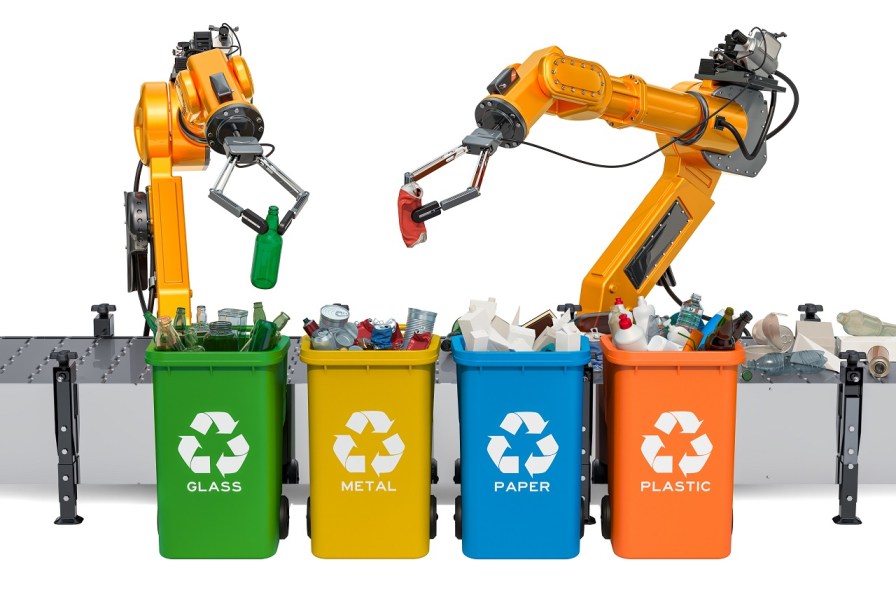Managing hazardous waste is a critical challenge for industries, governments, and environmental agencies worldwide. Toxic chemicals, radioactive materials, and biohazards pose significant risks to human health and the environment. Robotics is revolutionizing waste management by automating high-risk tasks, improving efficiency, and minimizing human exposure to dangerous substances. Advanced robotic systems, integrated with artificial intelligence (AI), sensors, and automation, are enabling safer and more effective hazardous waste handling, from collection and transportation to disposal and remediation.
Key Applications of Robotics in Hazardous Waste Management
1. Automated Waste Sorting and Identification
- AI-powered robotic arms equipped with sensors and machine learning algorithms can detect, classify, and separate hazardous materials from general waste.
- Spectroscopy and imaging technologies, such as X-ray fluorescence and hyperspectral cameras, help identify toxic substances for proper disposal.
- Automated sorting reduces contamination risks and ensures compliance with environmental regulations.
2. Remote-Controlled Robots for High-Risk Environments
- Remotely operated vehicles (ROVs) and robotic arms are used to handle radioactive waste, toxic chemicals, and explosive materials in environments too dangerous for human workers.
- These robots can be deployed in nuclear power plants, chemical spill sites, and industrial waste disposal facilities to collect and transport hazardous substances safely.
- Examples: Boston Dynamics’ Spot robot has been adapted for hazardous site inspections, while the Telerob Telemax is used for bomb disposal and toxic waste handling.
3. Robotics in Nuclear Waste Management
- The nuclear industry relies on teleoperated and autonomous robots to handle radioactive materials in highly contaminated zones.
- Robotic manipulators with lead shielding and radiation-resistant materials enable the safe handling of nuclear waste without direct human contact.
- Underwater robots, such as those used at Fukushima Daiichi, inspect and remove radioactive debris from nuclear reactors.
4. AI-Powered Drones for Environmental Monitoring
- Drones equipped with thermal imaging, LiDAR, and gas sensors are used for surveying hazardous waste sites and detecting toxic gas leaks.
- These drones provide real-time data to environmental agencies, enabling quicker response to hazardous spills and contamination.
- AI algorithms analyze drone-collected data to predict potential hazards and recommend waste management strategies.
5. Autonomous Waste Collection and Transport Systems
- Self-driving robotic vehicles equipped with AI and GPS can transport hazardous waste within industrial facilities, minimizing worker exposure.
- Specialized robotic tankers and vacuum systems safely remove and transport liquid hazardous waste from manufacturing plants and chemical storage sites.
- Autonomous systems improve operational efficiency by optimizing waste collection routes and reducing human error.
6. Robotics in Waste-to-Energy Processes
- Advanced robotic systems are being developed to assist in thermal treatment, gasification, and plasma arc disposal of hazardous waste.
- AI-driven robotic arms operate in extreme heat environments to manage incineration and chemical neutralization processes.
- These robots help in extracting valuable byproducts, such as metals and energy, from waste while ensuring safe disposal of toxic residues.
7. Bioremediation and Hazardous Site Cleanup
- Robotics is playing a key role in bioremediation, where microorganisms break down hazardous waste into non-toxic substances.
- Robots equipped with automated sprayers and soil-sampling tools help deploy bioremediation agents in contaminated environments.
- In oil spill cleanups, robotic skimmers and underwater drones monitor, contain, and remove oil pollutants from marine ecosystems.
Advantages of Robotics in Hazardous Waste Management
1. Improved Safety and Risk Reduction
- Robotics significantly reduces human exposure to toxic substances, radiation, and other hazardous environments.
- AI-driven safety mechanisms ensure precise handling of dangerous materials, minimizing accidents.
2. Enhanced Efficiency and Cost Reduction
- Automated systems process hazardous waste faster and more accurately than manual methods.
- AI-powered optimization reduces operational costs, increasing efficiency in industrial waste management.
3. Environmental Protection and Regulatory Compliance
- Robotics helps ensure strict compliance with environmental regulations by properly classifying and handling hazardous waste.
- AI monitoring systems detect potential leaks, chemical spills, or regulatory violations, enabling proactive corrective actions.
4. Increased Waste Recycling and Resource Recovery
- AI-powered sorting robots improve the recycling of valuable materials from hazardous waste.
- Autonomous waste treatment systems help extract metals, chemicals, and energy from hazardous materials, reducing landfill dependency.
Challenges and Limitations of Robotics in Hazardous Waste Handling
1. High Initial Costs and Infrastructure Requirements
- Developing and deploying robotic systems for hazardous waste management requires significant investment in technology and infrastructure.
- Many industries, especially in developing countries, may find it cost-prohibitive to implement robotic solutions.
2. Technical Limitations and Maintenance Challenges
- Robots operating in extreme environments face hardware limitations, such as corrosion, high temperatures, and mechanical wear.
- Regular maintenance and software updates are necessary to ensure reliability in hazardous waste handling.
3. AI Decision-Making and Ethical Concerns
- AI-driven robotic systems must make real-time decisions in unpredictable environments, which may lead to errors if not trained on diverse datasets.
- Ethical concerns around AI replacing human workers in hazardous waste management must be addressed through skill development and workforce adaptation.
4. Integration with Existing Waste Management Systems
- Many industries and municipalities use traditional waste handling systems that may not be fully compatible with advanced robotics.
- A phased approach is needed to integrate robotics without disrupting current waste disposal operations.
Future Outlook: The Next Generation of Robotics in Hazardous Waste Management
Advancements in AI, machine learning, and sensor technologies will further enhance the capabilities of robotics in hazardous waste management. Future innovations may include:
- Self-learning robots that adapt to different waste environments and optimize waste handling strategies.
- Swarm robotics, where multiple small robots work together for large-scale hazardous waste cleanup.
- AI-driven predictive analytics to anticipate waste hazards and deploy automated response measures in real time.
- Autonomous AI-driven recycling plants that efficiently process and neutralize hazardous waste with minimal human intervention.
As industries continue to prioritize safety, efficiency, and sustainability, robotics will play an increasingly vital role in managing hazardous waste, ensuring environmental protection, and safeguarding human health.
From Our Editorial Team
Our Editorial team comprises of over 15 highly motivated bunch of individuals, who work tirelessly to get the most sought after curated content for our subscribers.



